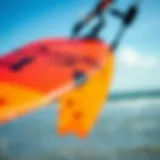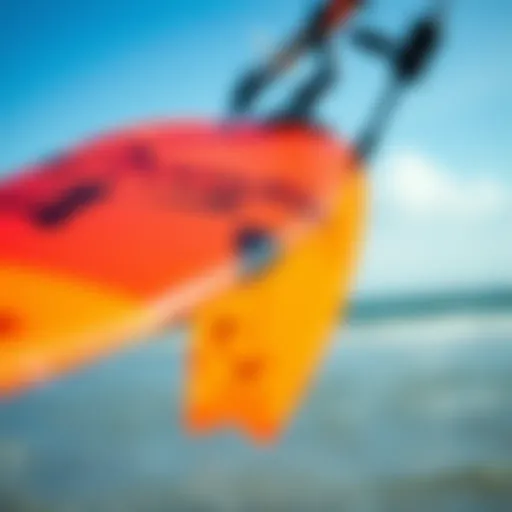Lake Erie Wave Forecast: Detailed Insights for Water Sports
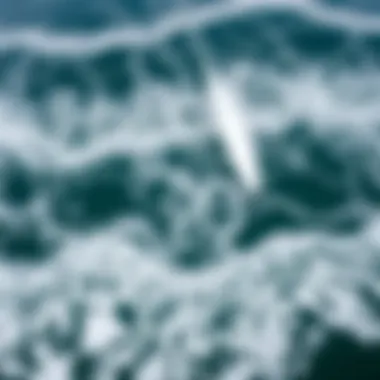
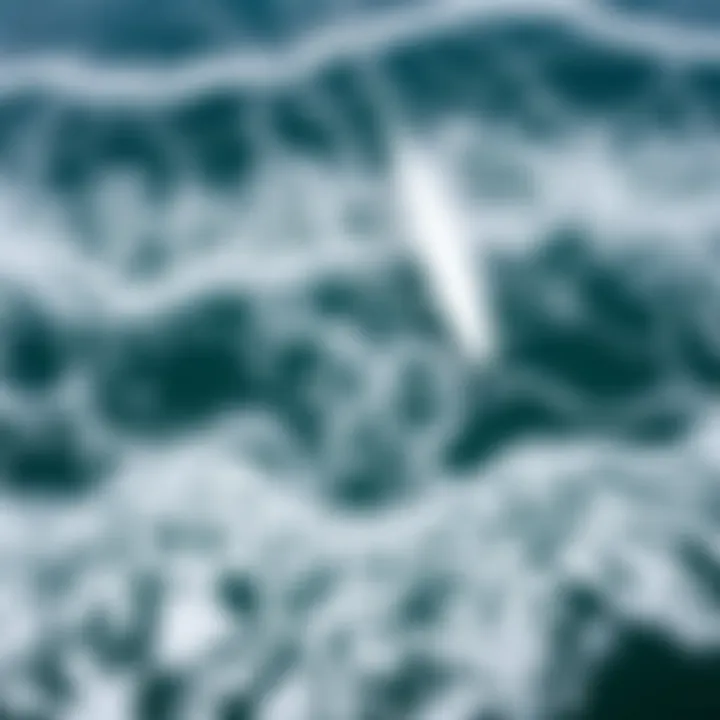
Intro
When it comes to Lake Erie, the waves are more than just water - they’re an experience, shrouded in intrigue and often unpredictable. Many kiteboarders and marine enthusiasts alike rely on wave forecasts to navigate their time on the water effectively. Understanding the factors that influence wave conditions is not just beneficial; it's crucial for making informed decisions about when to hit the waves. This article dives deep into the world of wave forecasting on Lake Erie, shedding light on methodologies, data sources, and the various elements that lend themselves to accurate predictions.
Wave forecasting isn't a simple endeavor. It involves a blend of scientific understanding, advanced technologies, and awareness of local conditions. Whether you're an experienced kiteboarder or a beginner looking to catch the wind for the first time, this comprehensive analysis aims to equip you with the necessary insights. By the end of this journey, you should have a better grasp of reading forecasts and anticipating changes on the water, potentially saving you from an unexpected turn of events.
As we traverse this topic, we’ll explore multiple angles—from gear insights tailored for both novices and seasoned riders to techniques that can enhance your performance on the water. It’s all about arming you with information and skills that will elevate your experience above the ordinary, ultimately making for safer and more exhilarating outings.
Let’s dive in.
Prologue to Lake Erie Wave Forecasting
Understanding wave forecasts for Lake Erie is pivotal for various activities that unfold on its bustling waters. From recreational kiteboarding to fishing excursions, accurate wave predictions help enthusiasts prepare adequately, ensuring safety and enhancing experience. The choppy waters of the lake can turn inviting on a sunny day but can quickly morph into an unpredictable realm if conditions shift without warning. Thus, wave forecasting serves not only as a practical necessity but also as a lifeline for those who cherish their time on the water.
Importance of Wave Forecasts
Wave forecasts hold immense value for both casual and seasoned water lovers. For kiteboarders, knowing when the wind is just right to create the perfect swell can make all the difference between an exhilarating outing and a dreary day spent onshore. A well-timed forecast can mean the difference between zipping across the lake’s surface with grace or struggling against formidable waves that turn joy into a scramble for safety.
Additionally, these forecasts influence local businesses and tourism. If kiteboarders, sailors, and anglers have a reliable scheme to check before they head out, they’re more likely to flock to Lake Erie, bringing economic activity along with them. Not only does this bolster local shops and eateries, but it nurtures a community of adventurers, eager to share their passion for the water. Just imagine the potential economic boost when friends gather, supplies in tote, categorized as 'going out' before heading into potential waves that forecast predicts.
Historical Overview of Lake Erie Conditions
Lake Erie holds a rich history of unpredictable weather patterns and wave activities. Those who’ve spent years near the lake have witnessed how conditions can shift dramatically. For instance, in the summer months, the lake offers relatively gentle waves—an ideal invitation for kiteboarding and sailing. However, as autumn approaches, it can transform into a tempestuous body, fueled by seasonal winds.
Notably, historical records provide insight into how climate events, such as the infamous blizzards of the 1970s, changed wave behavior, reshaping local perceptions and practices around water sports. In short, understanding the past helps today’s users navigate the complexities of the lake. This amalgamation of history and evolving conditions emphasizes the need for contemporary forecasting methods; after all, learning from yesteryears is key to enjoying Lake Erie’s current charm.
Accurate wave forecasts ensure safe and enjoyable experiences for everyone, intertwining the bond between nature and adventure.
Understanding Wave Dynamics
Understanding wave dynamics is essential for anyone involved in water activities, particularly for kiteboarders navigating the ever-changing conditions of Lake Erie. Waves are more than simple visual spectacles; they are a complex interplay of forces and phenomena that can greatly influence not just enjoyment but also safety on the water. The waves you see are manifestations of energy transfer, driven by wind and the unique characteristics of the lake itself. Having a grasp of these dynamics can mean the difference between an exhilarating day on the water and a hazardous one.
Wave Formation and Energy
Waves arise from the energy transfer between the wind and the surface of the water. Although one might think that large storms are the only creators of significant waves, calmer winds can also generate waves that kiteboarders must contend with. When the wind blows across the surface, it exerts a force on the water, generating ripples that can grow into sizable waves as the energy accumulates.
Here are a few factors that contribute to wave formation:
- Wind Speed: The stronger the wind, the more energy it transfers to the water. Higher wind speeds often lead to larger and more powerful waves.
- Fetch: This term refers to the distance over water that the wind blows in a single direction. A longer fetch means a greater area for energy accumulation, yielding larger waves.
- Water Depth: Shallow areas can cause waves to break earlier, while deeper sections allow for more energy storage before they crash.
Understanding how these factors interplay can help kiteboarders anticipate wave behavior and, most importantly, their impact on riding conditions. The energy of a wave is not uniform; the size and strength can vary with distance and water conditions, making it critical for enthusiasts to stay attuned to factors that might affect wave energy.
"Every kiteboarder's triumph or calamity often boils down to the nuances of wave energy. Knowing your waves is knowing your ride."
Influence of Meteorological Conditions
Weather plays a significant role in shaping the wave environment on Lake Erie. Kiteboarders need to pay attention not just to the wind itself but also to other meteorological factors that can influence wave formation and behavior. The interaction between atmospheric conditions and wave height can be intricate and nuanced.
Key weather conditions include:
- Wind Direction: This can radically change wave patterns. On Lake Erie, winds from specific directions may enhance wave heights, while others might flatten them completely. Knowing prevailing wind directions helps in choosing the right time and place for a session.
- Temperature: Variations in temperature can lead to atmospheric pressure changes that affect wind speed and direction, thereby influencing waves. A sudden drop in temperature might signal an incoming front that can generate sudden wave activity.
- Storm Systems: Approaching fronts and low-pressure systems are often precursors to increased wave activity. These systems can generate significant waves unexpectedly, requiring vigilant monitoring for safety.
By keeping tabs on these meteorological influences, kiteboarders can make informed decisions about when to hit the water and what conditions to expect. The dynamics of wave behavior are not merely a pastime; they are essential knowledge for anyone looking to enjoy Lake Erie safely and effectively.
Good resources to stay informed include National Weather Service and the Great Lakes Environmental Research Laboratory, providing real-time data and forecasts that can be crucial for planning your kiteboarding adventures.
Data Sources for Wave Forecasting
Wave forecasting is an intricate dance of data and technology, particularly when it comes to the unique conditions present in Lake Erie. Reliable forecasts depend heavily on the data sources that inform them. Having a deep understanding of these resources can make all the difference for kiteboarders, marine enthusiasts, and anyone engaged with the lake. Let’s explore some of the most critical elements in this field and the benefits and considerations that arise from them.
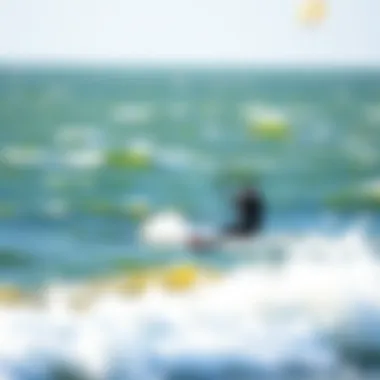
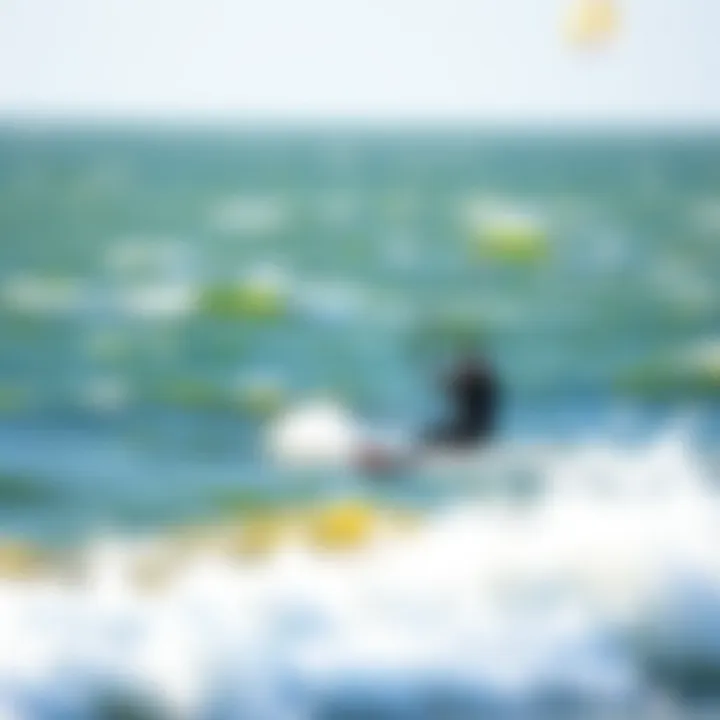
Satellite Imagery and Remote Sensing
One of the pioneering methods employed in wave forecasting is satellite imagery. This technology offers a bird's-eye view of the entire lake, capturing data that ground-based systems may miss. Satellites can monitor the surface of the water and gather vital information about wave heights, wind patterns, and even water temperatures, all at once.
Remote sensing techniques utilize both passive and active systems. For example, synthetic aperture radar (SAR) satellites can detect surface waves even through cloud cover, making them invaluable during stormy conditions. Some benefits of using satellite imagery include:
- Wide coverage: Satellites can observe vast areas, providing a comprehensive view of the lake’s condition.
- Real-time data: Modern advancements allow for near-real-time observations, giving an up-to-date perspective for the forecast.
- Historical data availability: Many satellite missions have been ongoing for years, allowing long-term trends and patterns to be analyzed.
Despite these advantages, there are also limitations to this technology. Accuracy, especially in rough weather, can sometimes be questionable, thus necessitating the verification of satellite data against other sources.
Buoy Data and Coastal Measurements
Buoys are another cornerstone of wave forecasting. These floating devices are strategically placed throughout Lake Erie and are equipped with sensors that measure wave heights, water temperature, wind speed, and direction. The direct readings from buoys provide localized information that can significantly enhance the reliability of forecasts.
Several factors underscore the importance of buoy data:
- Real-time monitoring: Buoys provide continuous data that reflect changes in wave conditions almost instantly.
- Localized insights: Unlike satellite data, buoy statistics provide specific information about particular areas on the lake, which can be critical for those engaged in activities like kiteboarding.
- Durability: Well-designed buoys can withstand harsh weather, ensuring consistent data flow even in less than ideal conditions.
Nevertheless, buoys are not without their challenges. Maintenance can be a constant issue, especially during heavy storms that might cause damage. Additionally, deploying enough buoys to cover all critical areas of the lake can be a logistical challenge.
Numerical Weather Prediction Models
Numerical Weather Prediction models, or NWP models, use mathematical equations based on physical laws to simulate the atmosphere. These models are vital for wave forecasting as they account for various meteorological factors that can influence wave dynamics on Lake Erie. NWP can predict how waves will evolve over time given certain initial conditions.
Some key advantages of using NWP models include:
- Forecasting capability: They can provide forecasts not just for wave heights, but also for wind conditions, precipitation, and temperature, thus offering a comprehensive outlook.
- High resolution: Advances in computing power have led to more detailed models, which can capture smaller-scale phenomena effectively.
- Adaptability: These models can be updated frequently as new data comes in, ensuring forecasts are as timely and accurate as possible.
On the flip side, NWP models can have limitations, such as sensitivity to initial conditions and numerically induced errors. Often, the complexity of Lake Erie’s microclimates poses a challenge, requiring ongoing refinement and adjustment to improve accuracy.
"In the world of wave forecasting, the right data can feel like a lifeline; it’s not just numbers on a page, but a navigator for safety and adventure on Lake Erie."
Culmination
In summary, the reliability of wave forecasts for Lake Erie fundamentally hinges on the synthesis of data from satellite imagery, buoy readings, and numerical weather prediction models. Each source offers benefits but also has its drawbacks, creating a landscape where understanding and integrating these elements is crucial. For kiteboarders and coastal activities, being aware of these data sources can make a world of difference in both planning and safety.
Methodologies in Wave Forecasting
In the intricate world of wave forecasting, especially regarding Lake Erie, the methodologies employed play a pivotal role. Accurate predictions not only enhance safety for water enthusiasts but also maximize the enjoyment of activities like kiteboarding. Various methods have sprung from the necessity to understand the ever-changing nature of water conditions, each with its own set of advantages and considerations.
Statistical Approaches
Statistical approaches utilize historical data combined with advanced mathematical techniques to forecast wave conditions. This methodology is particularly appealing due to its straightforwardness and reliance on empirical evidence. By analyzing past data, forecasters can identify patterns in wave height, frequency, and duration, all of which can provide meaningful insights.
This method involves using tools such as:
- Time Series Analysis: Examines wave conditions over time to forecast future behavior. For example, by looking at data from previous years, forecasters can estimate average wave heights during specific months.
- Regression Models: Regression can help in identifying relationships between different variables like wind speed and wave height. This establishes a predictive framework that helps in making very specific forecasts.
However, it's not all sunshine and rainbows. Limitations of statistical methods mean they may not fully account for rapid changes caused by unexpected weather events, so forecasters must complement them with other techniques. This balance between historical data and current conditions is crucial in providing comprehensive wave predictions.
Physical Modeling Techniques
On the other end of the spectrum, physical modeling techniques involve creating models that simulate wave dynamics in real time. In the context of Lake Erie, this means using computational fluid dynamics to replicate how water behaves under varying meteorological conditions.
Some aspects of this approach include:
- Numerical Models: These use complex mathematical equations to simulate wave prediction processes. For example, models like SWAN (Simulating Waves Nearshore) offer real-time forecasts by incorporating factors like wind direction and sea temperature.
- Laboratory Wave Tests: While less common for lake predictions, physical wave tanks can be used to visualize and study wave behavior under controlled environments, assisting in validating the computational models used in the field.
Overall, while physical modeling techniques are often more data-intensive, they allow for a high degree of accuracy, particularly in more chaotic atmospheres that simple statistical methods might miss. In an ever-changing environment like Lake Erie, this precise forecasting is invaluable for kiteboarders and other water enthusiasts looking to navigate the waves safely.
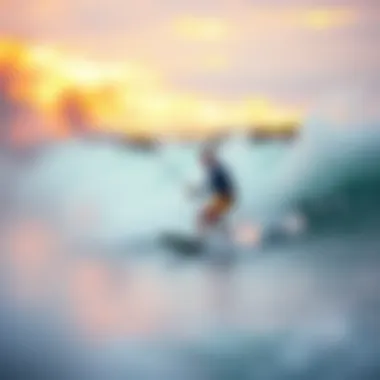

By employing a mix of both statistical approaches and physical modeling techniques, forecasters can significantly enhance the reliability of their predictions. As kiteboarding and similar activities continue to gain popularity, these methodologies will become increasingly crucial in ensuring that enthusiasts can make the most informed decisions possible.
Interpreting the Wave Forecast
Interpreting wave forecasts for Lake Erie goes beyond simply consulting a chart and jumping into the water. It's about understanding the nuances of data presented to ensure a safe and enjoyable experience on the water. This section elucidates the elements that define wave conditions, the benefits of a nuanced understanding, and considerations that need to be kept in mind.
One fundamental reason for digging into wave forecasts is that conditions can change quicker than you can say "Hang ten". Knowing how to read these forecasts could mean the difference between an exhilarating session and an unexpected tussle with Mother Nature. Wave forecasts offer a glimpse into what to expect, making them invaluable to anyone with plans for kiteboarding, sailing, or any sort of marine activity. The art of interpreting these forecasts enables you to choose the right time and conditions for your aquatic endeavours.
Key Indicators to Monitor
Several key indicators serve as touchstones when assessing wave conditions. Being attuned to these factors can provide a clearer picture of what’s happening on Lake Erie.
- Wave Height: This tells you how tall the waves are expected to be. Generally, larger waves can mean more fun for kiteboarders, but they can also bring increased risk if you're not prepared.
- Wave Period: The time it takes between consecutive waves. A longer period often indicates a more consistent wave pattern, which can be more predictable and enjoyable for riders.
- Wind Speed: How hard the wind is blowing can make a big difference. Stronger winds can create larger waves and enhance the experience for kiteboarding.
- Wind Direction: Where the wind is coming from dictates how the waves form. Side-shore winds can provide excellent conditions for kiteboarding as they create stable waves.
- Tide Levels: Tidal conditions can affect how the waves break. Understanding the tidal schedule can help you select the best spots.
Understanding Wave Heights and Periods
Wave heights and periods represent two of the core metrics needed for kiteboarding. Wave height refers to the vertical distance between the trough and crest of a wave, while the wave period is crucial for understanding the rhythm of the water.
- Short Periods: Waves arrive quickly but can be choppy, making them difficult to navigate. These conditions may require skilful handling.
- Long Periods: These generally result in smooth and powerful waves that offer a more fun experience for kiteboarding. For instance, a wave period of 8 to 12 seconds is typically ideal, allowing for a more enjoyable ride.
Awareness of these aspects not only enhances your performance but also ensures safety. Studying the relationship between wave height and period can sharpen your skills, allowing you to pick your day according to your level of expertise.
Wind Directions and Their Effects
Wind direction plays a pivotal role in how waves develop and subsequently affect your time on Lake Erie. Different wind directions create distinct riding conditions. Let’s break it down:
- Onshore Winds: These winds blow from the land towards the water, producing waves that generally have a more chaotic form but can also provide excellent conditions for launching into the sky.
- Offshore Winds: They blow from the water to the land, creating cleaner waves but diminishing them in height. This is often the time for more experienced kiteboarders due to less power in the waves.
- Cross-Shore Winds: Winds that blow parallel to the shoreline can maintain the consistency of wave size and are good for all skill levels.
Understanding how wind affects wave formation allows kiteboarders to make informed decisions, ensuring they hit the water under ideal conditions. Whether you’re looking to ride the curling crest of a wave or glide over the water's surface, wind direction could very well dictate the quality of your outing.
"In the world of kiteboarding, understanding wave forecasts transforms unpredictability into excitement."
Impact on Kiteboarding Activities
Kiteboarding on Lake Erie is a thrilling experience, a dance between wind and water that exhilarates both novices and pros. However, the success of kiteboarding is intricately tied to accurate wave forecasting. Kiteboarders rely not only on the wind but also on the wave conditions, which can make or break their day on the water. Understanding the potential impacts of wave forecasts can enhance enjoyment and ensure safety while allowing enthusiasts to maximize their time in the elements.
Optimal Conditions for Kiteboarding
Optimal kiteboarding conditions on Lake Erie hinge on a few critical elements. Typically, kiteboarders seek steady winds between 12 to 25 knots. This range offers the balance of power and control, crucial for performing tricks or simply enjoying a ride without the fear of being thrown off balance by erratic gusts.
Not to mention, wave height and period also play into the equation. Waves between 1 to 3 feet are often favorable as they provide enough surface to ride and jump while not being overwhelming. When the waves are too high, it can lead to an unpredictable ride, potentially causing falls or mishaps. Kiteboarders also prefer a medium wave period, as longer intervals can lead to flatter conditions in between swells, which is less exciting and harder for jumps.
Some key factors can create ideal kiteboarding conditions:
- Surf-Friendly Wind Directions: North to northeast winds often produce the most consistent wave patterns. Learning local patterns can equip riders with the knowledge to predict conditions better.
- Clear Lake Conditions: After a storm or heavy rain, the lake can become choppy and dirty, while calm days often yield clearer conditions. Watching environmental changes like precipitation can provide insights into water texture and wave behavior.
- Seasonal Insights: Spring and early autumn can offer the best conditions in Lake Erie, where wind patterns stabilize, and water temperatures are more appealing.
Having this understanding allows kiteboarders to align their schedules with the best conditions, turning a day on the water from chance into an experience of precision.
Safety Considerations
While kiteboarding presents adventure, it is not without risks. Safety should always be paramount, and this aligns with the need for better forecasting. High winds and large waves can lead to harmonic dangers if misjudged. Predictive tools help kiteboarders assess whether conditions are safe for their capability levels.
Some essential safety tips include:
- Pre-Evaluation of Weather Conditions: Before heading out, check reliable forecasts specific to Lake Erie. Online sources like NOAA often provide localized wind and wave information that can save time and trouble.
- Understanding Personal Limits: Every rider has a different threshold. Conditions that may be perfect for an expert might be dangerous for a beginner. Respect your comfort and skill level above pressure.
- Proper Gear: Using appropriate kite sizes for current wind conditions and wearing a helmet can prevent injuries. Investing in quality gear that suits the forecast can mean the difference between a safe session and an accident.
- Buddy System: Kiteboarding with a partner ensures that assistance is nearby in case of mishap. It's wise not to go solo, especially on days when conditions are questionable.
"The ocean is a playground, but like any playground, it's wise to be careful unraveling its mysteries."
In essence, linking wave forecasts to kiteboarding not only ensures a good time but also a safe one. As enthusiasts navigate the waters of Lake Erie, understanding both the optimal conditions and necessary precautions shapes a fulfilling experience.


Challenges in Wave Forecasting
Wave forecasting for Lake Erie isn’t just a stroll in the park. It’s a whole journey through the watery realm filled with twists and turns. The challenge lies in the variability and ever-changing nature of the elements involved. From sudden winds kicking up waves to shifting weather patterns that can turn a calm day into chaos, the unpredictability can be daunting. Here, we look into the nitty-gritty of those challenges that experts and enthusiasts alike face when predicting Lake Erie's waves.
Limitations of Current Models
The backbone of wave forecasting is based on complex models and algorithms that attempt to predict wave heights and periods. However, these models are not perfect. One significant limitation is that many forecasting models are based on historical data that may not always accurately represent current conditions. For instance, if Lake Erie experiences unusual meteorological events, those models could become obsolete, leading to inaccurate forecasts.
- Resolution Issues: Many models operate on a broad scale, meaning they might miss local phenomena that occur in specific areas of the lake.
- Data Dependency: The effectiveness of these models is heavily reliant on quality input data. If the data collected from buoys or satellites is flawed, the output will also be flawed.
In essence, these limitations can hinder the ability of kiteboarders and other water sports enthusiasts from making informed decisions about their activities. If one is counting on a model that can’t quite cut it, the risks can be substantial.
The Role of Human Error
Even with cutting-edge technology, human error plays a significant role in wave forecasting. The simplest mistakes—like misreporting wind speed or sensationalizing weather changes—can lead to disruptions in forecasting accuracy. Moreover, interpreting data requires a level of expertise that not everyone possesses. Misinterpretation by forecasters can send misleading signals to those who rely on them.
Some common human errors include:
- Miscommunication of Information: A forecaster may inadvertently relay incorrect data which can shape the expectations of sailors and kiteboarders.
- Assumptions Over Data: Relying on personal experiences rather than concrete data can skew forecasts and lead to risky conditions on-the-water.
"Understanding that human error can skew forecasts is vital; it’s always best to stay updated and informed through trusted channels."
To see reliable forecasts, kiteboarders must remember that they are navigating not only the waves but also the murky waters of forecasts made by people, flawed though they may be. Addressing these challenges begins with recognizing them, which lays the groundwork for more accurate predictions in the future.
Future Directions in Wave Forecasting
As lake conditions evolve and user demands shift, the need for reliable wave forecasting grows ever more crucial. Here, we explore what the future holds for wave forecasting, especially for those who spend their time savoring the adrenaline of kiteboarding and other water activities on Lake Erie. This section delves into technological advancements and strategies for integrating data to improve accuracy.
Technological Advancements
The rise of technology offers new pathways to enhance wave forecasting capabilities. For example, the application of artificial intelligence (AI) has been making waves—quite literally—in prediction models. These intelligent systems can analyze massive sets of meteorological data in a fraction of the time it takes a human expert. Machine learning algorithms can recognize patterns that often elude traditional models. This could transform how forecasts are generated, leading to quicker and more precise information.
Moreover, the introduction of drones to gather real-time data over water surfaces is a game changer. Drones can fly over Lake Erie, capturing video and photographic data to complement buoy information, which can sometimes be limited in coverage. This allows for a better visual understanding of wave conditions and helps forecast models reflect the reality on the water accurately.
In parallel, remote sensing technologies continue to evolve. Satellites equipped with advanced sensors can enable forecasters to track changes in weather patterns far away from the lake's shores, providing a comprehensive overview that supports anticipatory actions instead of reactive decisions. The fusion of these technologies not only enhances predictive capacity but also provides timely alerts that are critical for those at sea.
Integrating Data for Improved Accuracy
The future of wave forecasting will also hinge on the integration of diverse data sources. As we discussed in previous sections, data from satellites, buoys, and numerical models can be quite valuable on their own. However, when these vital resources are combined, the result is a clearer picture of the conditions at play. This holistic approach allows forecasters to cross-verify data, ensuring that forecasts remain as accurate as possible.
For instance, bringing together buoy data, satellite imagery, and AI analysis offers a multi-faceted view of anticipated wave conditions. The continuous stream of information helps adjust forecasts more dynamically, accounting for any number of external influences such as sudden winds or temperature shifts. Moreover, as community-resilient practices grow in popularity, local knowledge becomes paramount. Input from seasoned kiteboarders, boating clubs, and fishing communities can complement the tech-driven data, adding invaluable people insights.
"Forecasting is both an art and a science, weaving together numbers and human intuition."
By tapping into these advancements and data integrations, Lake Erie wave forecasting is set to become more reliable, encouraging not just a safe experience for watersports enthusiasts but also ensuring that adventurers can push their limits with confidence. As kiteboarding continues to attract both experienced riders and newcomers alike, these innovations will pave the way for a brighter and more predictable future on the water.
Closure
In a world where outdoor activities thrive on accurate weather data, understanding Lake Erie's wave forecasting emerges as a crucial knowledge base, especially for enthusiasts of kiteboarding and other water sports. This conclusion wraps up an exploration of key elements that paint the landscape of wave forecasting in this Great Lake.
The significance of reliable wave forecasts cannot be overstated. They serve not only as essential tools for instructors and athletes but also as pivotal aids for casual beach-goers and boaters. With unpredictable weather being a frequent character in the narrative of Lake Erie, having a handle on forecasting allows individuals to make informed decisions, increase safety, and enhance overall experiences out on the water.
From the methodologies discussed, including statistical approaches and advanced physical modeling techniques, we see that forecasting is anything but simple. It's a sophisticated dance between data collection, interpretation, and real-time environmental conditions. The integration of satellite imagery with buoy data and numerical weather prediction models creates a robust framework for anticipating wave dynamics.
Strong points are made throughout this analysis on the importance of learning how to interpret the forecasts effectively. Recognizing the core indicators, such as wave heights and wind directions, empowers users to align their activities with optimal conditions, thus maximizing both fun and safety. It’s not just about riding the waves; it’s about understanding them—learning to read the water, much like one would read a book.
Moreover, future directions in wave forecasting promise exciting innovations. With advancements in technology, including improved data integration techniques, the waiting game for accuracy in wave forecasting might soon be a footnote in our history. The fascination with the science behind forecasting will keep evolving, pushing the envelope of what we know today. With each leap forward, enthusiasts will benefit from more reliable insights, better safety protocols, and ultimately, more pleasurable experiences.
So, we arrive at a juncture where understanding Lake Erie’s wave forecasts is essential—not merely for those living on its shore but for anyone looking to harness the lakes' unpredictable nature. Mastery over the waves isn’t just a sport; it’s an alliance with the natural world through knowledge and respect.
"Knowledge is a treasure; shared wisdom is its key."
Ensuring responsible practices when enjoying Lake Erie also relies heavily on an active understanding of wave conditions. As this article unfolds, it’s clear that the interplay between the water and wind is a story worth knowing well. Fortifying our recreational activities with knowledge provides a pathway to not only be informed but also to be stewards of our watery playgrounds.
In summary, diving deep into wave forecasts is not just relevant; it’s a vital element for every kiteboarder, traveler, instructor, or adventurer. As those who enjoy the thrill of waves and the beauty of Lake Erie, embracing responsible practices in the face of nature’s unpredictability is the ultimate goal for ensuring our beloved locations remain enjoyable for generations to come.










